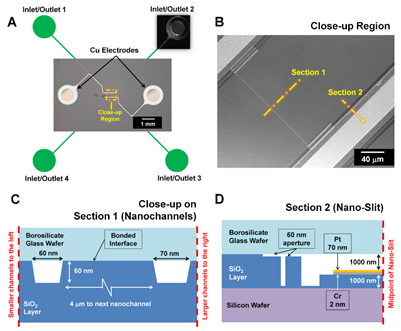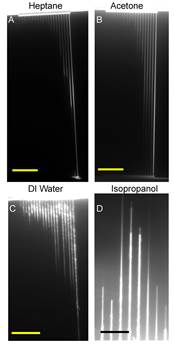Reports: ND952817-ND9: Investigation of Fundamental Dynamic Petrophysical Properties of Gas-Bearing Shales
Matthew T. Balhoff, University of Texas at Austin
Technical Overview
Shales are expansive hydrocarbon-bearing nanoporous rocks which exhibit extremely low and often unpredictable permeability to fluids. Nanofluidic experiments in synthetic representations of tight porous media such as shale are a developing approach to researching anomalous nanopore-scale fluid transport mechanisms.
During exploratory nanofluidic investigations we made an unexpected observation: imbibition of various wetting liquids in an array of different-sized horizontal, two-dimensional silica nanochannels terminated within a channel as a function of hydraulic diameter and liquid type. This front termination is not predicted by the classic Washburn equation for capillary flow, which establishes diffusive dynamics in horizontal channels. The large discrepancies in the reported imbibition trends hint unaccounted physical mechanisms at play. Various explanations for the anomalous static imbibition measurements are negated; hydrodynamics, thermodynamics, surface chemistry and mechanics were all taken into consideration for this analysis. The atypical imbibition data are explained by the enhanced influence of both surface forces and elastocapillary and solid surface deformation due to shearing and negative pressures (suction) at the nanoscale. We introduce a phenomenological model which demonstrates how van der Waals forces, common to all interfaces, lead to local menisci deformation and an average reduction in capillary pressure. An expression for the approximate capillary pressure of a symmetric nanoscale meniscus in a cylindrical pore space is derived; its difference from the macroscopic capillary pressure can be expressed by an effective contact angle. Elastocapillary deformation of solid walls exacerbates this deformation as well as an increase in effective viscosity, and we also describe models for these effects.
We detail, for the first time, the facile and replicable construction of two-dimensional physical representations of shale matrix pore-networks in nanofluidic devices using standard cleanroom nanofabrication methods. Like shale, the reported network geometries are mostly nanoscale, irregular, and composed of hydraulically resistive paths (throats) meeting at junctures (pores) to mimic the perceived low topological connectivity of shale. The geometry also includes microscale grid patterns that border the nanoscale networks and represent microfracture pathways of greater hydraulic conductivity (dual-porosity). Unlike shale, fluid interfaces and tracers in these transparent networks are directly visible with optical microscopy techniques. This approach allows direct quantification of each device’s network topology and other geometrical properties, including pore size distribution and connectivity. In actual shale samples, such properties are only inferred and are uncertain due to the limitations of common petrophysical analytical techniques and sample imaging methods. The main techniques used in the development of our nano-network master patterns include the use of transmission electron microscopy (TEM) grids with lacey carbon support film as shadow masks, thermal evaporation/deposition, and reactive ion etch (RIE). Master patterns were successfully replicated with polymer materials.
Impact of Research
The implications of the findings and developed models extend beyond nanochannels to nanoporous media. Improved descriptions of nanoscale imbibition and menisci is of importance to a variety of biological, geophysical, and technological topics, including transport and liquid loss in nanoporous (unconventional) hydrocarbon-bearing media, soil science, groundwater flow, carbon capture and sequestration; transport in nanoporous organs; cavitation in internal medicine; lab-on-a-chip drug delivery systems; and function-based nanofluidic devices. Tuning of a system’s Hamaker constant by fluid solvent and solute selection can potentially enhance or decrease fluid imbibition and drainage effects as needed. Changes in the dimensions of a nanoporous media or conduit can potentially be used to characterize either the intrinsic capillary forces or mechanical properties of the solid.
To our knowledge, this work reports the first construction of “reservoir-on-a-chip” versions of shale. The documented two-step fabrication scheme is relatively simple, robust, and cost-effective; cleanroom tools are required for master pattern fabrication, but with subsequent soft lithography techniques, multiple batches of chips can be generated from a single master substrate. The key contribution of this fabrication scheme is the successful use of lacey carbon support films as shadow masks and the resemblance of the resulting copper hardmask to tight, dual-porosity, heterogeneous porous media such as shale. Sag of the support films and redeposition of copper hardmask material during RIE are identified as limiting parameters of the fabrication scheme.
PI and Student Career Impacts
The PI’s research has historically been in the areas of modeling, both at the pore and reservoir scale. Nanofluidics is a new direction for the PI. The work here has a resulted in a new experimental lab for the PI which includes both microfluidics and nanofluidics research as well as core-scale modeling. He has recently submitted a proposal to NSF to continue fundamental research using nanofluidics. The student, Shaina Kelly, is scheduled to complete her PhD in 2015. She has been very successful as a PhD student, receiving many awards. She has accepted a position as a petrophysicist at ConocoPhillips starting in December 2015. The PIs and student have published 2 peer-reviewed papers, have a second accepted for publication, and several under preparation.
Figures
Figure 1. (A) Schematic of the nanofluidic chip design with an inset brightfield microscopy image of the fluidic network of two low aspect ratio microchannels/nano-slits with an array of nanochannels connecting them.
Figure 2. All fluids were doped with Rhodamine B and images are captured with a Zeiss Axiovert 200M FLM.
Figure 3. Ratio of imbibition termination length (lt), as detected by Rhodamine B fluorescence, over total length of the nanochannel array (L = 250 mm) versus hydraulic diameter of the nanochannels for the tested fluids.
Figure 4. The data suggest a trend between imbibition success, summarized by Sw, and calculated Hamaker constants for a system of two films of liquid (fluid 2) interacting across a film of air (fluid 3), A232.
Figure 5. (A) SEM image of a mechanically-milled surface of an oil-window Eagle Ford shale sample.
Figure 6. (A) Schematic workflow diagram of the fabrication scheme.
Figure 7. SEM and DIC images that characterize challenges in different steps of the fabrication process.
Figure 8. Relative frequency distributions of synthetic 2D grain sizes and synthetic 2D pore body and throat sizes in the nanofluidic patterns.



















